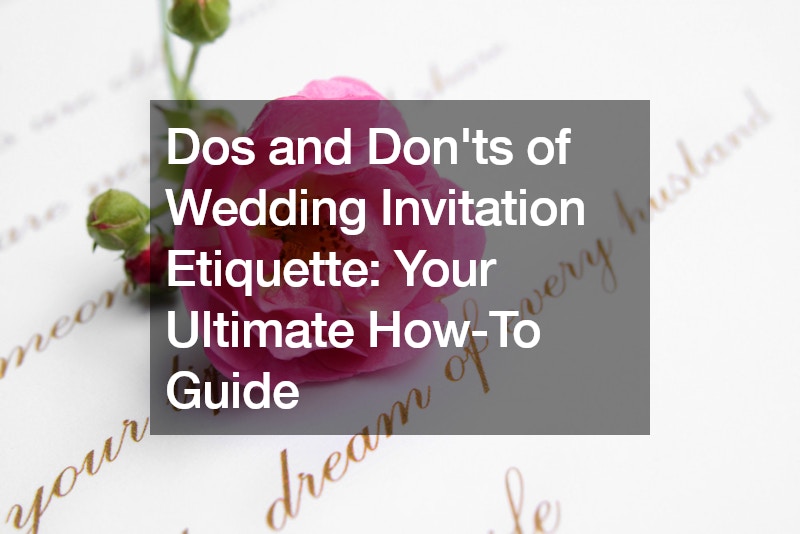Sending out wedding invitations is a significant milestone in your wedding planning journey. These invitations not only provide essential details about your big day but also set the tone for the event. To ensure your wedding invitation process goes smoothly and respectfully, it’s crucial to follow proper etiquette. In this ultimate how-to guide, we’ll explore the dos and don’ts of wedding invitation etiquette to help you navigate this important aspect of your wedding planning.
Dos:
1. Send Invitations in a Timely Manner: Tradition suggests sending out wedding invitations six to eight weeks before the wedding date. However, for destination weddings or if many guests need to travel, consider sending them out three months in advance.
Additionally, sending save-the-date cards six to eight months ahead can help guests plan accordingly.
2. Set a Reasonable RSVP Deadline: Give your guests ample time to respond by setting the RSVP deadline two to three weeks before the wedding date. This allows you to finalize important details like seating arrangements and catering.
3. Include Wedding Website Information: Your wedding website is a valuable resource for guests to find additional details about your wedding, such as accommodations, registry information, and venue directions. Include the website URL on your save-the-date cards and consider adding it to your formal invitations with a small insert.
4. Respectfully Communicate Adults-Only Policy: If you’re hosting an adults-only wedding, address your invitations to each guest by name rather than using “and family.” Additionally, you can include a note on your wedding website to clarify the adults-only policy.
5. Clearly Indicate Dress Code: To avoid any confusion, include the dress code on your invitations or reception cards. Whether it’s black tie, cocktail attire, or casual, providing clear guidance ensures guests dress appropriately for your event.
6. Properly Address Envelopes: Take the time to address envelopes correctly, including the return address on the back flap. If your wedding reception is for immediate family only, avoid inviting guests to the ceremony only to prevent misunderstandings.
Don’ts:
1. Don’t Include Registry Information on Invitations: While it’s tempting to share your registry details, it’s considered impolite to include them directly on the wedding invitations. Instead, include this information on your wedding website where guests can find it easily.
2. Avoid Last-Minute Changes to Guests’ Plus-Ones: If you’ve specifically addressed an invitation to a guest’s partner, it’s not appropriate for them to bring someone else. Politely explain your preference for the wedding to be limited to close friends and family.
3. Don’t Overlook Postage for RSVP Cards: Ensure that the RSVP envelopes are pre-addressed with the correct return address, usually that of the designated recipient, such as the bride’s parents. Additionally, include postage on these envelopes for guests’ convenience.
4. Avoid Overcrowding Invitations with Extra Information: While it’s essential to provide necessary details, overcrowding your invitations with excessive information can be overwhelming for guests. Keep the wording concise and clear to avoid confusion.
5. Don’t Forget to Proofread: Before sending out your wedding invitations, double-check all details for accuracy, including dates, times, and spellings of names. It’s essential to ensure that everything is correct to avoid any last-minute corrections or misunderstandings.
By following these dos and don’ts of wedding invitation etiquette, you can ensure that your invitations are tasteful, respectful, and informative. Remember, effective communication is key to ensuring that your guests have all the information they need to celebrate your special day with you. Whether you’re planning an intimate indoor ceremony or a grand celebration at an outdoor wedding venue, proper etiquette sets the stage for a memorable event for you and your guests.
Guest List Management:
Creating and managing your wedding guest list is a crucial aspect of wedding planning. Start by determining your priorities and setting clear guidelines for who you want to invite. Consider factors such as budget, venue capacity, and the intimacy of the event. When navigating tricky guest list situations, such as limited space or family tensions, communicate openly and respectfully with all parties involved. Be prepared to make difficult decisions, but prioritize inviting those who are most important to you and your partner.
Customization Options:
Personalizing your wedding invitations allows you to add a special touch to your big day. Explore various customization options, such as choosing unique designs, colors, fonts, and paper types that reflect your style and personality as a couple. Consider incorporating meaningful details, such as monograms, photos, or quotes that symbolize your love story. Whether you opt for DIY invitations or work with a professional stationer, make sure your invitations represent you as a couple and set the tone for your wedding celebration.
Handling RSVPs and Guest Responses:
Managing RSVPs is an essential part of wedding planning to ensure an accurate headcount for your event. Set a clear RSVP deadline, typically two to three weeks before your wedding date, to give guests ample time to respond. Provide multiple RSVP options, such as online RSVP forms, mail-in response cards, or phone RSVPs, to accommodate guests’ preferences. Follow up with guests who haven’t responded by the deadline to confirm their attendance. Be prepared to handle late or non-responses gracefully and adjust your seating arrangements and catering numbers accordingly. Effective RSVP management will help streamline your wedding planning process and ensure a smooth and stress-free event day.
.


